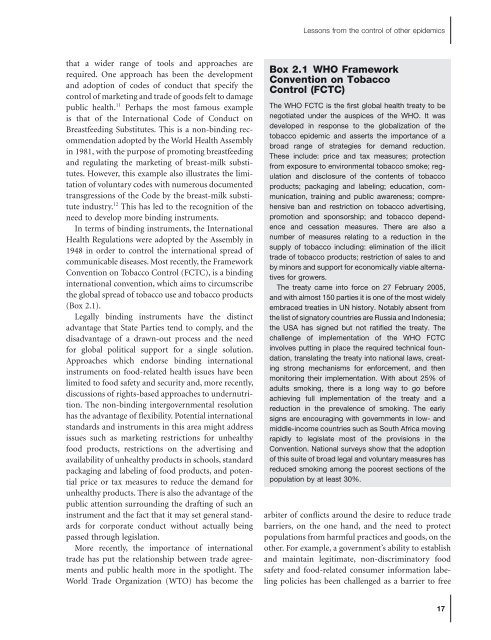Preventing Childhood Obesity - Evidence Policy and Practice.pdf
Preventing Childhood Obesity - Evidence Policy and Practice.pdf
Preventing Childhood Obesity - Evidence Policy and Practice.pdf
Create successful ePaper yourself
Turn your PDF publications into a flip-book with our unique Google optimized e-Paper software.
Lessons from the control of other epidemics<br />
that a wider range of tools <strong>and</strong> approaches are<br />
required. One approach has been the development<br />
<strong>and</strong> adoption of codes of conduct that specify the<br />
control of marketing <strong>and</strong> trade of goods felt to damage<br />
public health. 11 Perhaps the most famous example<br />
is that of the International Code of Conduct on<br />
Breastfeeding Substitutes. This is a non - binding recommendation<br />
adopted by the World Health Assembly<br />
in 1981, with the purpose of promoting breastfeeding<br />
<strong>and</strong> regulating the marketing of breast - milk substitutes.<br />
However, this example also illustrates the limitation<br />
of voluntary codes with numerous documented<br />
transgressions of the Code by the breast - milk substitute<br />
industry. 12 This has led to the recognition of the<br />
need to develop more binding instruments.<br />
In terms of binding instruments, the International<br />
Health Regulations were adopted by the Assembly in<br />
1948 in order to control the international spread of<br />
communicable diseases. Most recently, the Framework<br />
Convention on Tobacco Control ( FCTC ), is a binding<br />
international convention, which aims to circumscribe<br />
the global spread of tobacco use <strong>and</strong> tobacco products<br />
(Box 2.1 ).<br />
Legally binding instruments have the distinct<br />
advantage that State Parties tend to comply, <strong>and</strong> the<br />
disadvantage of a drawn - out process <strong>and</strong> the need<br />
for global political support for a single solution.<br />
Approaches which endorse binding international<br />
instruments on food - related health issues have been<br />
limited to food safety <strong>and</strong> security <strong>and</strong>, more recently,<br />
discussions of rights - based approaches to undernutrition.<br />
The non - binding intergovernmental resolution<br />
has the advantage of flexibility. Potential international<br />
st<strong>and</strong>ards <strong>and</strong> instruments in this area might address<br />
issues such as marketing restrictions for unhealthy<br />
food products, restrictions on the advertising <strong>and</strong><br />
availability of unhealthy products in schools, st<strong>and</strong>ard<br />
packaging <strong>and</strong> labeling of food products, <strong>and</strong> potential<br />
price or tax measures to reduce the dem<strong>and</strong> for<br />
unhealthy products. There is also the advantage of the<br />
public attention surrounding the drafting of such an<br />
instrument <strong>and</strong> the fact that it may set general st<strong>and</strong>ards<br />
for corporate conduct without actually being<br />
passed through legislation.<br />
More recently, the importance of international<br />
trade has put the relationship between trade agreements<br />
<strong>and</strong> public health more in the spotlight. The<br />
World Trade Organization ( WTO ) has become the<br />
Box 2.1 WHO F ramework<br />
C onvention on T obacco<br />
C ontrol ( FCTC )<br />
The WHO FCTC is the first global health treaty to be<br />
negotiated under the auspices of the WHO. It was<br />
developed in response to the globalization of the<br />
tobacco epidemic <strong>and</strong> asserts the importance of a<br />
broad range of strategies for dem<strong>and</strong> reduction.<br />
These include: price <strong>and</strong> tax measures; protection<br />
from exposure to environmental tobacco smoke; regulation<br />
<strong>and</strong> disclosure of the contents of tobacco<br />
products; packaging <strong>and</strong> labeling; education, communication,<br />
training <strong>and</strong> public awareness; comprehensive<br />
ban <strong>and</strong> restriction on tobacco advertising,<br />
promotion <strong>and</strong> sponsorship; <strong>and</strong> tobacco dependence<br />
<strong>and</strong> cessation measures. There are also a<br />
number of measures relating to a reduction in the<br />
supply of tobacco including: elimination of the illicit<br />
trade of tobacco products; restriction of sales to <strong>and</strong><br />
by minors <strong>and</strong> support for economically viable alternatives<br />
for growers.<br />
The treaty came into force on 27 February 2005,<br />
<strong>and</strong> with almost 150 parties it is one of the most widely<br />
embraced treaties in UN history. Notably absent from<br />
the list of signatory countries are Russia <strong>and</strong> Indonesia;<br />
the USA has signed but not ratified the treaty. The<br />
challenge of implementation of the WHO FCTC<br />
involves putting in place the required technical foundation,<br />
translating the treaty into national laws, creating<br />
strong mechanisms for enforcement, <strong>and</strong> then<br />
monitoring their implementation. With about 25% of<br />
adults smoking, there is a long way to go before<br />
achieving full implementation of the treaty <strong>and</strong> a<br />
reduction in the prevalence of smoking. The early<br />
signs are encouraging with governments in low - <strong>and</strong><br />
middle - income countries such as South Africa moving<br />
rapidly to legislate most of the provisions in the<br />
Convention. National surveys show that the adoption<br />
of this suite of broad legal <strong>and</strong> voluntary measures has<br />
reduced smoking among the poorest sections of the<br />
population by at least 30%.<br />
arbiter of conflicts around the desire to reduce trade<br />
barriers, on the one h<strong>and</strong>, <strong>and</strong> the need to protect<br />
populations from harmful practices <strong>and</strong> goods, on the<br />
other. For example, a government ’ s ability to establish<br />
<strong>and</strong> maintain legitimate, non - discriminatory food<br />
safety <strong>and</strong> food - related consumer information labeling<br />
policies has been challenged as a barrier to free<br />
17

















